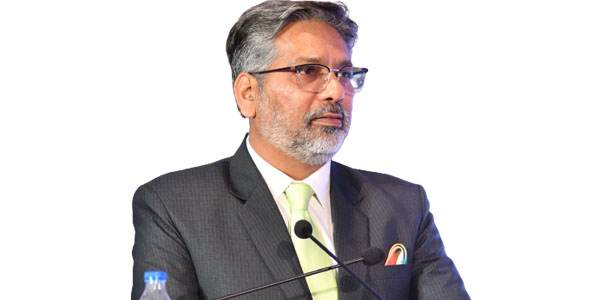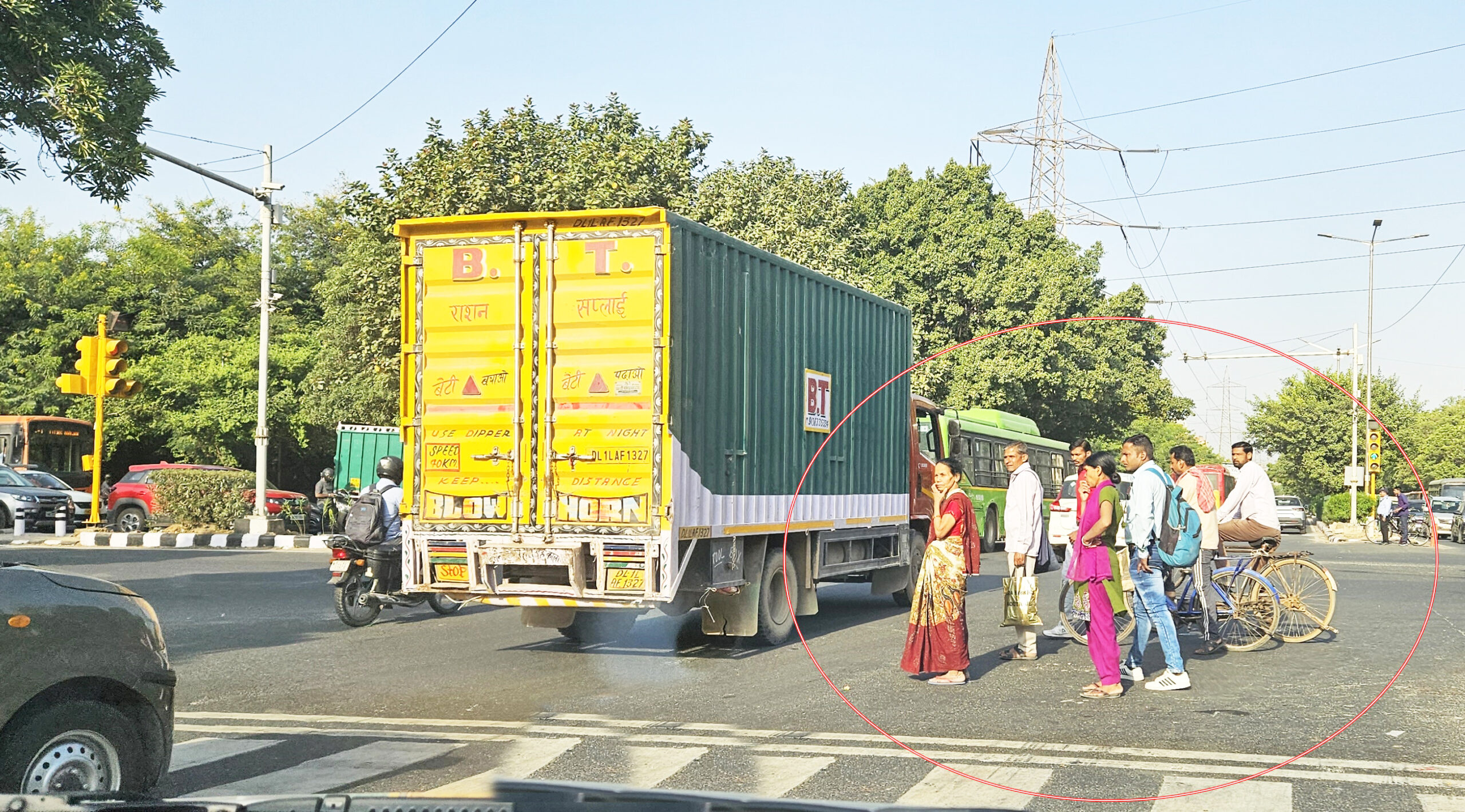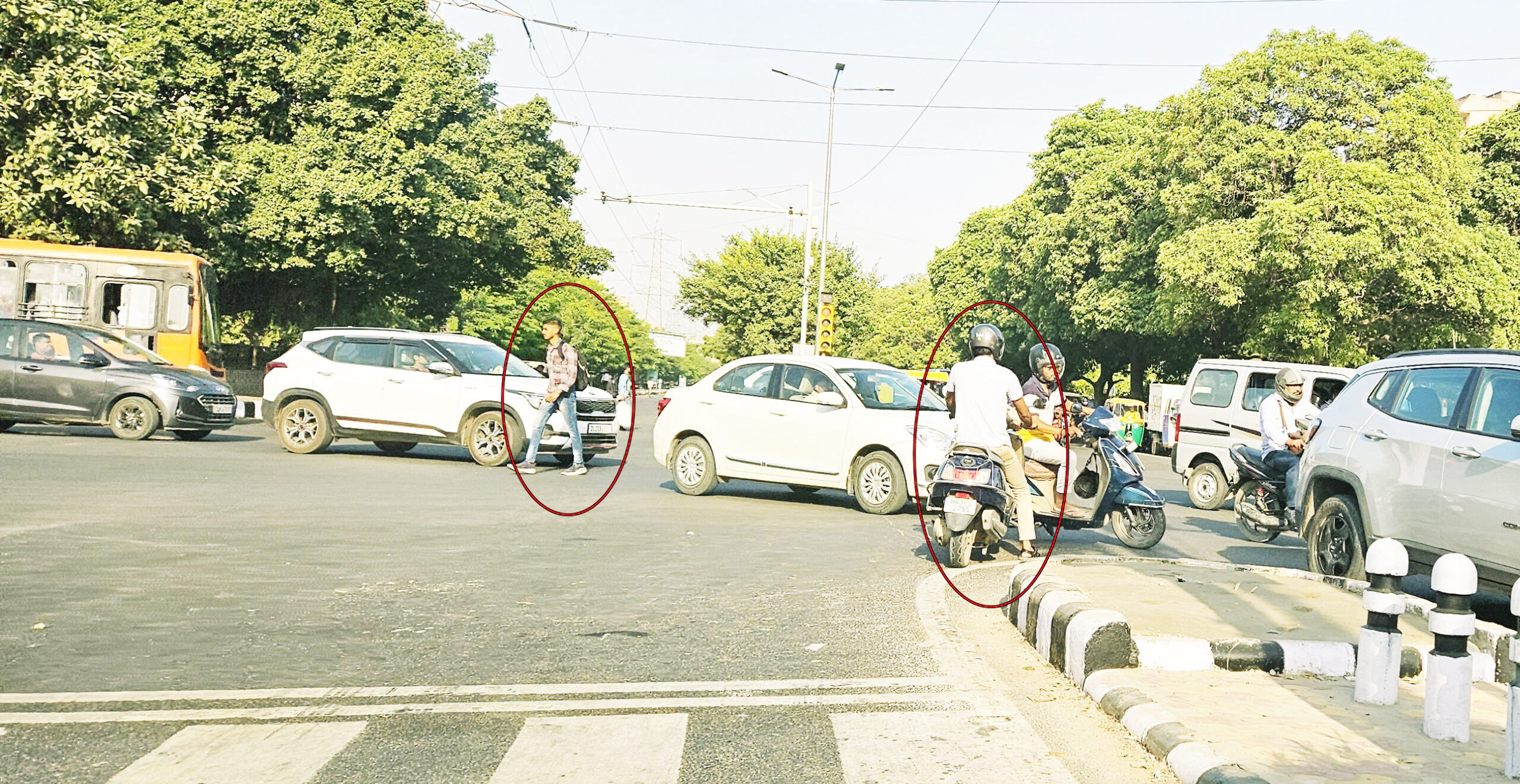
Dr. Rajiv Mathur, Regional Advisor Asia, OSPAs
India’s roadways, often described as a bustling symphony of chaos and courage, present an intricate tapestry of challenges and contradictions. From heart-stopping traffic snarls to jaw-dropping acts of road rage, the nation’s road safety woes have been well-documented. In this expansive exploration, we’ll delve deeper into the harrowing statistics, dissect the weird irregularities of Indian road culture, and shed light on potential remedies. Buckle up, for this rollercoaster ride is equal parts shocking, amusing, and ultimately, a call to action
The Road Safety Odyssey: India’s Worrying Statistics
To truly grasp the perplexing nature of India’s road safety crisis, let’s take a closer look at the numbers and dive into some hair-raising examples from various cities across the nation.
Accidents Unleashed: A Multitude of Mishaps
As per the last Road Safety Report of Ministry of Road Transport & Highways (MoRTH), Government of India, in the year 2021 alone, India reported a staggering 4,12,432 road accidents. This translates to an average of 1130 accidents every day. But what do these numbers mean in the context of real-life incidents?
- Mumbai’s Traffic Squeeze: Mumbai, the city that never sleeps, witnessed an astounding 29,442 road accidents in 2021. That’s like having an accident every 18 minutes.
- Delhi’s Dismal Distinction: The national capital, Delhi, is no stranger to gridlock, recording 17,939 accidents in 2021. To put it in perspective, there was an accident every 29 minutes.
Fatalities: Lives Interrupted
In the same year, 1,53,972 lives were claimed by these accidents, averaging 422 deaths every day. The grim statistics are more than just numbers; they are lives abruptly cut short.
- Kolkata’s Perilous Pedestrians: Kolkata saw 4,654 lives lost on its roads in 2021. That’s like losing an entire community every week.
- Chennai’s Challenging Crossings: Chennai, known for its sweltering heat and dosas, recorded 4,157 fatalities. That’s as many lives lost as the number of dosas served in a bustling eatery.
Injuries: The Unseen Suffering
Road accidents also resulted in injuries to 3,84,448 people in 2021, illustrating the hidden trauma that survivors endure.
- Bengaluru’s Bruised Bikers: Bengaluru, the Silicon Valley of India, had 11,347 injuries in 2021. Imagine a room filled with injured individuals, each one battling their own road to recovery, every day.
- Hyderabad’s Hurt Hikers: Hyderabad had 7,899 injuries, enough to fill a small sized stadium with people nursing their wounds.
The Eccentricities of Indian Road Culture
India’s roadways are an arena where the bizarre, the chaotic, and the audacious intersect. Let’s dissect some of these quirks and qualms that make driving in India an experience unlike any other.
Aggression on the Road: The Battle for Dominance
In the chaotic realm of Indian roads, the unspoken motto, opposite to the old Lucknowi culture of pehle aap, appears to be ‘me first.’ It’s a world where the law of the jungle reigns supreme, where the strong assert their right of way.
- Northern Bravado: In the northern regions of India, a peculiar brand of bravado prevails. The phrase ‘Tu Janta Hai Mera Baap Kaun Hai?’ (Do you know who my father is?) is the trump card of choice when it comes to asserting dominance. It’s a unique form of assertiveness that can be heard echoing through the streets, often used to leave others in no doubt about one’s lineage.
- Mumbai’s Bhai: In the bustling streets of Mumbai, the term ‘Bhai’ (brother) is tossed around like a secret code, and nobody’s quite sure who’s who. Each vehicle seems to carry a sense of mystery, leaving you to wonder if that stern-looking gentleman in the SUV is, in fact, some bhai or just another commuter. It’s a city where the lines between real-life bhai and everyday people blur into a web of ambiguity.
- Rajni’s Effect: Head down south, and you’ll encounter a phenomenon of an entirely different kind. It’s as if the spirit of Rajnikanth, the legendary actor known for his fearless on-screen persona, infects every road user. No matter the vehicle they’re in, drivers and pedestrians alike exude an invincible attitude. It’s not just about confidence; it’s about embracing the Rajnikanth-like aura, navigating the roads with an air of fearlessness, as if they’re the ultimate road warriors.


Traffic Violations: Rules, What Rules?
Traffic rules in India often seem like mere suggestions, with drivers taking it upon themselves to rewrite the road code.
- Dash through Red Lights: In almost all the bustling streets cities of this vast country, the act of running red lights has been elevated to nothing short of a daring sport. Here, traffic signals often appear as mere decorations, their authority overshadowed by a collective rush to cross the intersection. It’s a mesmerizing yet heart-pounding spectacle, where drivers flirt with the boundary between safety and audacity. The red signal might indicate a halt, but for many, it’s an invitation to test their mettle in the race against time.
- Wrong-side Warriors: Across India, the practice of wrong-side driving is not merely a deviation from traffic norms; it’s an art form. It’s an exhibition to the road user’s audacious belief that it’s not about choosing the right lane; it’s about taking the lane that feels right at that precise moment. Whether it’s a shortcut to evade congestion, a faster route to reach a destination, or a sheer disregard for conventional rules, wrongside warriors navigate the road with a flair for the unconventional. It’s a driving dance where the choreography is anything but predictable.
Honking: India’s Unending Symphony
In India, honking isn’t a mere form of communication; it’s an intricate symphony composed by a flock of impatient souls. At any given junction, in the heart of the road, or while awaiting the changing of a traffic signal, the air resonates with a disharmony of horns. It’s as if drivers participate in a collective belief that the volume of their honk directly correlates with the speed at which they’ll reach their desired destination. This deafening orchestra of horns, often akin to a well-rehearsed ensemble, plays on, day and night.
- Honk Happy Habits: At the crossroads and intersections that pepper India’s streets, the chorus of honks becomes an involuntary yet omnipresent backdrop to the urban melody. It’s not merely a communication tool; it’s an unspoken assertion of existence on the road. The drivers wield their horns like musical instruments, each honk a note in the ever-evolving composition of city life. They drive forward with a symphony of impatience that fills the atmosphere, shaping the soundtrack of India’s bustling streets.
- Midnight Melodies: Even when the city sleeps and the moon casts its silvery glow on the streets, some drivers believe in maintaining the nocturnal tradition. At 2:17am, when the streets are hushed and they are the sole travellers on the road, they consider it their sacred duty to serenade the slumbering city with the melodious sounds of their horns. It’s a peculiar nightly habit that, to the uninitiated, might seem more like a nightcap of cacophony rather than a chorus. Nevertheless, these midnight maestros of honking are devoted to their unique nocturnal symphony, echoing through the sleeping cityscape.
Safety is the Last Priority: Living on the Edge
Safety regulations like helmets and seat belts are frequently met with resistance, perceived as a direct challenge to one’s masculinity or personal freedom. The ensuing defiance against these life-saving measures takes various forms:
- Helmet Hesitation: Helmets, a proven shield against life-altering head injuries, often become victims of scorn and negligence. Many riders view them as cumbersome headgear, a hindrance to their freedom on the road. A conspicuous number of riders choose to discard their helmets, even in the face of alarming accident statistics that demonstrate the life-saving potential of this simple accessory. The hesitation to don helmets persists, fuelled by the erroneous belief that a ride without one signifies liberation from the rules of road safety.
- Seat Belts – A Fashion Faux Pas: In the case of seat belts, the disdain takes a different form. They are either tucked away, neglected, or relegated to serving as coat hangers in vehicles. Their primary purpose, which is safeguarding lives in the event of a collision, is often forgotten or dismissed. Many drivers view seat belts as a fashion faux pas, detracting from the im age they wish to project. This disregard for seat belts comes at a tremendous cost, as data shows that they significantly reduce the risk of injury or death in road accidents.
- The Mobile Phone Distraction Epidemic: Perhaps the most menacing challenge to road safety is the relentless intrusion of mobile phones. The increasing prevalence of smartphones has transformed them from communication devices into insidious distractions, making them ubiquitous culprits in road accidents. Drivers, even during bumper-to-bumper traffic, are often caught in the web of mobile phone distractions. Some brazenly watch cricket matches or movies while navigating their vehicles. The implications of this mobile phone madness are dire, with attention diverted from the road and reactions dulled, leading to a surge in accidents and near misses.
Jaywalkers: The Fearless Pedestrian Avengers
Indian pedestrians, it seems, are cut from a different cloth. They are a valiant bunch, often indulging in acts of derring-do that could give you jitters behind the steering wheel. These everyday adventurers exhibit a zest for life, even on the mundane journey from one side of the road to the other. 80% of the pedestrians killed on Indian roads are men and in the age group of 45-60 years. Are they the most restless and hurried people or their reflexes are getting slower with time?
- Green Means Go: The term ‘jaywalker’ takes on a new level of significance in India. These footpath trailblazers have an uncanny ability to interpret the traffic lights. As soon as the light turns green on the road they wish to cross, they pounce into action. It’s as though they’ve deciphered a secret code, their bodies and instincts synchronized to the rhythm of the traffic signal. Their promptness is almost startling, giving a whole new meaning to the phrase ‘seize the moment.’
- Fearless F1 Aspirants: These brave souls take it a step further. Rather than keeping to the sidewalk or the designated pedestrian crossing, they choose to walk almost in the very heart of the road, often in groups. They move with a panache that rivals that of professional race car drivers. Each stride exudes an aura of invincibility, as if they’re auditioning for a real-life version of Formula 1. Their ability to navigate the chaotic roadways is nothing short of impressive, and their attitude is a testament to the indomitable spirit that characterizes many Indian pedestrians. The road, for them, is an endless racetrack, and they’re the fearless contenders in this high-stakes adventure.
- Divide(r) and Rule: A growing concern in road safety revolves around pedestrians who exhibit risky behaviours by barging through grills and railings at road dividers. This perilous act requires a sharp eye, flexibility, and, above all, courage. When these individuals daringly leap into the midst of fast-moving traffic, their best gesture, often driven by necessity, is to look towards the other side for a fleeting glimmer of hope. This precarious manoeuvre is a stark reminder of the challenges pedestrians face in navigating India’s bustling roadways.
The Road Ahead: Concerns for Future Generations
As we gaze into the rearview mirror of India’s road safety crisis, the reflection reveals a bleak panorama. The next generation faces an uphill battle against a culture that often prioritizes recklessness over responsibility. Here’s a closer look at the multifaceted concerns that cloud the road ahead for India’s youth:
- Safety and Well-being: The young generation is coming of age amidst a road culture where safety often takes a backseat to urgency. The consequences of this apathy can be heart-wrenching.
- Mental Health Toll: The incessant stress and anxiety spawned by aggressive road behaviour have the potential to carve deep scars on the mental health of young individuals. A daily commute through the maddening traffic snarls leaves everyone perpetually on the edge. The subsequent struggles with anxiety and stress underscore the hidden toll of India’s roadways, one that extends beyond physical safety.
- Economic Impact: The economic ramifications of road accidents ripple far and wide. A severe road accident leaves one incapacitated and unable to work, resulting in a substantial loss of income. The high medical expenses and the surge in insurance claims not only affects livelihood but also victim’s family’s well-being. This economic burden is one that the next generation could ill afford to bear.
- Traffic Congestion: India’s chaotic roads not only jeopardize safety but also exact a toll on productivity and the quality of life for the younger generation. In any city, traffic congestion results in residents spending an average of 45 to 60 minutes longer in their daily commutes, impacting their work-life balance and the quality of time spent with family and friends. This perpetual gridlock is a silent adversary that impedes the youth’s pursuit of a balanced life.
- Environmental Concerns: The environmental impact of India’s roadways extends beyond the cacophony of horns and traffic congestion. The incessant honking, a seemingly harmless road ritual, contributes to noise pollution, raising stress levels and impacting sleep quality. The carbon footprint left by the snarl of vehicles adds to the country’s environmental woes. The cities of Mumbai and Chennai, already grappling with air quality issues, serve as stark reminders that the next generation will inherit an environment far more fragile.
Revolutionizing India’s Road Safety: A Five-Pronged Approach
India’s road safety crisis demands an overhaul, a transformation that necessitates a comprehensive and multifaceted strategy. There are lessons to be learned from successful road safety initiatives across the globe. To navigate toward safer and more disciplined roadways, we must embark on an initiative that encompasses five key pillars of change:
- Road Safety Education: The foundation of a safer road culture begins with education, and schools are the breeding grounds for responsible road users. It is imperative to implement comprehensive road safety education programs from a young age. Children must be taught the importance of adhering to traffic rules and the consequences of reckless behavior. The early imbibing of safe road practices not only ensures a more responsible next generation but also acts as a catalyst for change within families.
- Strict Enforcement: Laws, without rigorous enforcement, remain mere words on paper. To foster discipline on the roads, traffic laws must be enforced vigorously. The deterrent effect of penalties and fines for violations is crucial in curbing rule-breaking behavior. The imposition of consequences for flouting road regulations sends a clear message that road safety is not negotiable. The enforcement of laws becomes the backbone of a safer road environment.
- Public Awareness Campaigns: The need to raise awareness about safe road behavior is paramount. Public awareness campaigns must utilize a wide array of media platforms to convey their message effectively. These campaigns should not merely preach the importance of road safety but also vividly illustrate the harrowing consequences of reckless driving. The power of storytelling and relatable narratives can drive home the message that safety is not a choice but a collective responsibility.
- Infrastructure Improvement: The physical landscape of the roads plays a pivotal role in ensuring safety. Investment in better road infrastructure is essential. This includes pedestrian-friendly walkways, well-marked lanes, and efficient traffic management systems. Infrastructure that prioritizes road safety can act as a silent enforcer of discipline. Well-structured roads reduce the chances of chaos and rule violations, making it easier for road users to adhere to regulations.
- Technology Integration: The integration of technology solutions can revolutionize road safety. Traffic cameras, automated traffic enforcement systems, and real-time traffic updates can provide real-time feedback and reinforcement of road rules. These technological aids not only make it easier to monitor and enforce traffic regulations but also provide drivers with a constant reminder of the importance of adhering to these rules.
Navigating Towards a Safer Future
In the surreal carnival that is India’s roadways, there’s no denying the bizarre charm that makes it uniquely Indian. However, as the numbers and anecdotes reveal, it’s a charm tinged with danger. It’s time for a paradigm shift, a cultural revolution that prioritizes safety, discipline, and the well-being of all road users.
In the midst of the chaos, there’s hope. The world has shown us that road safety can be achieved through education, enforcement, awareness, infrastructure, and technology. It’s up to us, the fearless passengers on this rollercoaster, to demand change, embrace the lessons of the world, and steer India’s roadways toward a safer and brighter future.
So, fasten your seatbelts, put on your helmets, and let’s embark on a journey to transform India’s roads from a rollercoaster of chaos into a path of discipline and safety, where future generations can navigate without fear.